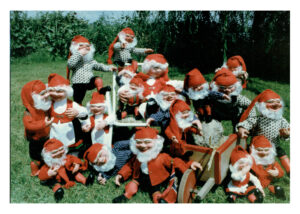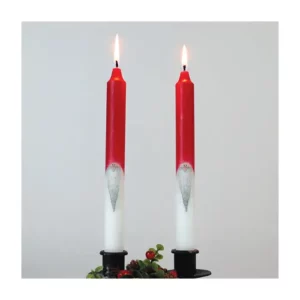
A nisse (usually Norwegian) and a tomte (usually Swedish) are similar characters. They are both solitary, mischievous domestic sprites responsible for the protection and welfare of the farmstead and its buildings. Tomte literally means “homestead man” and is derived from the word tomt which means homestead or building lot. Nisse is derived from the name Nils which is the Scandinavian form of Nicholas.
 Click for the beloved Tomte books by Astrid Lindgren
Click for the beloved Tomte books by Astrid Lindgren
A tomte is described as an older, little man about the size of a young child. He wears old often ragged clothes, usually gray or navy, and sports a bright red cap on his head. He resides in the pantry or barn and watches over the household and farm. He is responsible for the care of the farm animals, especially the horses. The tomte or nisse has an enormous capacity for work but will not tolerate anyone’s interference. It is believed that a clean and orderly home or farm is an indication that this domestic sprite resides there.
Tomtar and nisser require very little of the humans they work for. They demand only the respect and trust of the farmer and a bowl of julegrøt (Christmas porridge) with butter on Christmas Eve. These spirits will not remain in a home where respect is lacking and thus the farm will not thrive and the farmer will be reduced to poverty.
The Nisse that Got No Butter
 A nisse considers porridge his due and is greedy for butter. The legend When the Nisse Got No Butter on His Christmas Porridge illustrates the consequences of tampering with his porridge.
A nisse considers porridge his due and is greedy for butter. The legend When the Nisse Got No Butter on His Christmas Porridge illustrates the consequences of tampering with his porridge.
One Christmas Eve a servant girl decided she would play a trick on the nisse. She hid the butter for his grøt at the bottom of the bowl. When the nisse saw there was no butter on his Christmas porridge, he went to the shed and killed the best cow. He wanted to show them he did not appreciate them begrudging him a little bit of butter. He returned to the barn to eat the porridge anyway. When he discovered the butter at the bottom of the bowl, he felt so bad that he walked to the neighbor’s farm, took their best cow, and led her back to the stall of the cow he had killed.

According to legend, domestic spirits often steal from a neighbor to increase the prosperity of the farm where they make their home. This is demonstrated in the legend The Nisse Who Stole Fodder:
 There once was a farmer who had no hay left for his farm animals. He sat one day and complained about it when he heard a voice say, “I will help you.” The farmer looked around but couldn’t find where the voice came from. After a few days he noticed his animals were thriving although they had no food. One day the farmer decided he would take his chances and cross the ice to a neighboring village to buy some hay. When he was in the middle of the ice a small man appeared and asked where he was going. The farmer replied that he was going to buy hay. The little man said not to worry because he would help him so the farmer returned home. One night the farmer noticed by moonlight a little man leading one of his cows across the ice to a neighbor’s farm. When they returned the cow was loaded down with hay. Then the farmer realized the little man was a nisse and he had been fetching hay for the animals.
There once was a farmer who had no hay left for his farm animals. He sat one day and complained about it when he heard a voice say, “I will help you.” The farmer looked around but couldn’t find where the voice came from. After a few days he noticed his animals were thriving although they had no food. One day the farmer decided he would take his chances and cross the ice to a neighboring village to buy some hay. When he was in the middle of the ice a small man appeared and asked where he was going. The farmer replied that he was going to buy hay. The little man said not to worry because he would help him so the farmer returned home. One night the farmer noticed by moonlight a little man leading one of his cows across the ice to a neighbor’s farm. When they returned the cow was loaded down with hay. Then the farmer realized the little man was a nisse and he had been fetching hay for the animals.
Norwegian Nisser
The present day version of the julenisse is very different form the legends of the domestic tomte or nisse. The julenisse is portrayed as an older, good natured, adult-sized man (not surprisingly the size of an uncle or father) with a long white beard and a red hat and suit. He carries a sack of toys on his back, visits children in their homes on Christmas Eve and always asks, “Are there any good children here?” (“Er det noen snille barn her?”) Many Scandinavian children also believe he lives at the North Pole where he has a workshop.
The Norwegian julenisse is very much like the American Santa Claus and is based upon the German legend of St. Nicholas (nisse is a derivative of Nicholas), who was the patron saint of children and seamen. He was known for his many kind acts toward children.
In Sweden the jultomte is accompanied by the Christmas goat who pulls his sleigh as he delivers gifts to the children’s homes. In pagan times, the god Thor was believed to ride across the sky in a chariot pulled by two goats. Christians adopted the goat as a Christmas symbol. The chained figure of a buck is a representation of Lucifer who was conquered by the good Saint Nicholas and is destined to accompany his master on his journey to distribute gifts to the children. Today the goat is a benign straw figure but still a very well-known Christmas symbol.
Legends of the domestic nisse and tomte meet the modern day version of the julenisse or jultomte in the tradition of leaving a bowl of julegrøt with butter out in the barn or in the house for them on Christmas Eve. This tradition is still practiced in Scandinavian homes.
Visit the Tomtar & Nisser that wait to guard your home!
